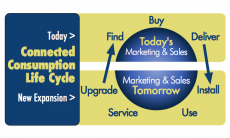The next frontier in technology is the Internet of Things (IoT)—the connection of everyday physical objects like thermostats, door locks, and household appliances to the Internet. The IoT promises a future where these devices talk to each other to create an ideal user experience across all devices (from toasters to cars) for customers. We’re starting to get glimmers of what this connected future might look like (e.g. Nest’s devices), and it is equal parts scary and awesome. While it’s too early to know what that the IoT will actually look like, what is clear is that the IoT will revolutionize marketing. Here’s how:
Rise of omnichannel consumers
Having trouble connecting with your customers and providing a consistent cross-channel experience when your only channels are social media, your website, mobile, email, traditional print and broadcast advertising, and your bricks-and-mortar establishments? Just wait until every home and office appliance is a channel for interacting with your brand!
More opportunities for ecommerce
Mobile commerce is becoming a very promising area and what drives it is that people have their phones with them all the time. With the IoT, your customers will be able to interact with you from a whole host of devices beyond phones and tablets. Every interaction will have the potential for e-commerce.
Going forward, great marketing will be about making a strong emotional connection and less about the specific device or channel. Marketers will have to become even more channel/device agnostic with both strategies and tactical execution than they are now.
Big data will get much much bigger
Marketers have access to an unparalleled amount of information about the habits and interests of their customers, but with the IoT, the data available today will be dwarfed by what will be available to harvest and analyze.
Today, marketers recognize the importance of meeting customers on all the channels they’re on, but often struggle with collecting data on customers across all channels and then analyzing the data. That’s about to get much harder—and much better at the same time—with the IoT. The IoT will bring a proliferation of connected devices and these devices will provide many more ways to interact with customers and offer many more places to collect data from. Both of these are double-edged swords for marketers because on the one hand there is the distinct possibility of being overwhelmed with data, but on the other hand, with the unprecedented amount of data, there is the opportunity to provide awesome customer experiences.
Nest, the smart thermostat and smoke detector company, is one of the leaders in creating IoT hardware and using the hardware to collect data on its customers. It uses the data to improve the products, providing a better experience for the customer.
Privacy issues will be manifold
With the increase in data will come new privacy issues we can’t comprehend yet. We’re still working out how to protect privacy with “old” media like email. Hardly a week goes by without news of a brand suffering from a data breach of some kind. Even when a company keeps its data secure, there are many ways to mess up, as Target demonstrated a couple years ago when The New York Times reported how Target was able to figure out when its customers became pregnant and tailor its marketing for them. The IoT will offer even more intimate information about people and marketers will have to quickly learn how to use the data without being invasive.
Eventually, the IoT will be normal
The IoT will follow the same curve we’re seeing with social media and mobile: It will be novel and exciting and really innovative brands will get in on the action as early adopters. However, as the technology becomes widespread, it will quickly morph from a magical experience to the new baseline customers expect. Marketers will need to be prepared for this shift.







